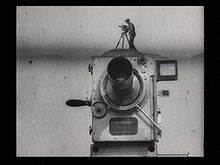Kino-Eye
[2] However, by the mid-1920s, as Richard Taylor writes, "The conventional structures of the cinema industry in its three major aspects - production, distribution, and exhibition - had been shattered by the Civil War.
Kino-Eye developed as a response to what was happening in much of Soviet cinema at the time Vertov entered the playing field.
[5] While the new technique of montage and its proponents like Kuleshov and Eisenstein had begun to change the landscape of Soviet film, Vertov's Kino-Eye found popularity in their universality.
Jay Leyda writes: "While most films produced at that time approached revolutionary subject-matter with attitudes strongly influenced by the cheapest theatrical and adventure-film traditions, both in selection and in method, Vertov's films dared to treat the present and, through the present, the future, with an approach as revolutionary as the material he treated.
Jeremy Hicks writes that the Bolsheviks had long espoused the newspaper as the main source of fact and truth.
Vertov's cinematic form was a direct response to the truth that he found in journalism and its representations of everyday life.
Like many of its contemporaneous art forms, Kino-Eye was an attempt to model objectivity amid the contradictions of Soviet modernity.
By manipulating the camera to exploit movement along with new editing techniques that focused on film speed and transitions, Kino-Eye would construct a new, objective depiction of reality.
[13] Vertov also hoped that Kino-Eye would make cinema more intelligible to the common people, so that it could truly become a mass media form.
[1][15] Hicks writes about Kino-Eye as an early expression of documentary, as Vertov's films were not staged and captured "real life" in order to create "tremendous rhetorical force.
In his writings, Vertov chastised contemporary cinematography as being too concerned with elements outside of the film shot itself, such as music or literature.
Vertov and his followers that took up Kino-Eye as their method of film production referred to themselves as kinoks ("cinema-eye men") rather than "cinematographers."
The kinoks organized themselves in the same way the Soviets did - headed by the "Council of Three" (Vertov and two others), the rest were thought of as comrades in film-making.
Their form was deeply tied to Soviet socialism, as they wanted to make cinema available to a working class audience.
Largely considered Vertov's lone masterpiece,[16] Man with a Movie Camera is the greatest example of Kino-Eye.
"[23]Unashamedly avant-garde, Man with a Movie Camera captures every day actions such as getting out of bed, washing, and even giving birth.



